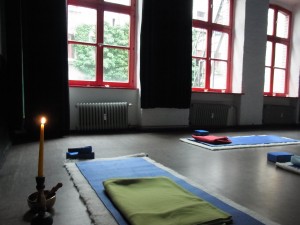 The final installment in our 4 part series about Yamas and Niyamas would not be complete without talking about passion, self-reflection and surrender. In part one of this series, we talked about Patanjali´s limbs of classical yoga practice and started to explore the ethical guideposts within them (aka the Yamas). In part two of Yamas and Niyamas, we spoke about aspects of self-control with regard to possessions, sexuality and energy. Part three covered clarity and calm with regard to your inner life–the first installment of the Niyamas.
The final installment in our 4 part series about Yamas and Niyamas would not be complete without talking about passion, self-reflection and surrender. In part one of this series, we talked about Patanjali´s limbs of classical yoga practice and started to explore the ethical guideposts within them (aka the Yamas). In part two of Yamas and Niyamas, we spoke about aspects of self-control with regard to possessions, sexuality and energy. Part three covered clarity and calm with regard to your inner life–the first installment of the Niyamas.
The Yamas and Niyamasa are ethical elements of practice, and they are what takes yoga from the level of physical exercise to a deeper, potentially life-altering point. All aspects of human life can be touched if a person is able to understand and practice the deep implications of yoga. Once again, the Yamas are ethical principles about attitudes and behaviors that cause suffering (greed, dishonesty, violence, etc). The Niyamas (the second limb) are the attitudes and behaviors that yogis can work towards to cultivate happiness and to improve their lives and environments.
Tapas
“Tapas” is an attitude of passion and commitment. Some people think of it as discipline, or austerity. The word actually comes from the Sanskrit verb ”to burn”-so Tapas is all about fiery consistency. I think that we often get this mixed up with difficulty and striving. I prefer to think of it more as a gentle flame that inspires us to keep going, even when the tasks at hand seem very, very mundane! Think of doing your family’s laundry, or having the same conversation again and again with a friend who is struggling to understand something about themselves. Tapas brings us to do these things with patience, engagement and dedication.
What areas of your life and practice feel repetitive or lukewarm? Could being more present and engaged with these areas make you feel more excited about them?
Svadhaya
Svadhaya means active self-reflection, or study of the self. This doesn’t mean egotistical navelgazing. Rather, it’s about learning enough about yourself to see that you are part of something much, much bigger. Asana practice brings the body and mind to a place of quiet, so that we can experience our union with everything. Western Science calls this web of interbeing ´ecology´. The Yogic scriptures call it ´reality´. Both are correct, and Svadhaya is a practice that allows us to recognize this. Svadhaya is an attitude that helps us to transcend projection, isolation and other illusions that come standard with a human body and mind.
How does yoga help you ”see” yourself in different ways? Do you have other practices that nourish this ability?
Isvara Pranidahna
The last Niyama is Isvara Pranidahna, which means ‘surrender’ or ‘faith’. Simply put, this Niyama is about chilling the fuck out. Isvara Pranidahna means that you do your best, in the moment, with the tools you have, and then you release your attachment to the outcome. As the Bhagavad Gita says, “the future is none of your business, so don’t worry about it!” Focus on doing your best in the present moment, and leave the rest for another day.
Do your expectations and worries about a particular project or relationship hold you back from enjoying it fully in the moment? If you take a trial run at not worrying about controlling that thing, even for a minute or two, how does it feel?
Our Hatha yoga in English is a discipline of non violence that is about practice and experience, rather than dogma or rules. We offer yoga in Kreuzberg for all levels of physical ability. We believe that yoga in Berlin and around the world should be nurturing to your body and soul. And as we become happier and more balanced as individuals, we can go out and make our world a better place. We are happy to offer you a home in our sangha and hope we can offer you a place of belonging, growth and rest.






